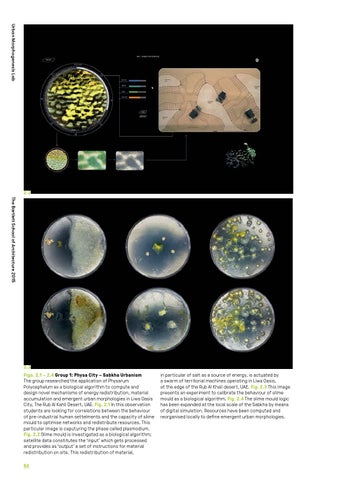Urban Morphogenesis Lab
2.2 The Bartlett School of Architecture 2015
2.3 Figs. 2.1 – 2.4 Group 1: Physa City – Sabkha Urbanism The group researched the application of Physarum Polycephalum as a biological algorithm to compute and design novel mechanisms of energy redistribution, material accumulation and emergent urban morphologies in Liwa Oasis City, The Rub Al Kahli Desert, UAE. Fig. 2.1 In this observation students are looking for correlations between the behaviour of pre-industrial human settelments and the capacity of slime mould to optimise networks and redistribute resources. This particular image is caputuring the phase called plasmodium. Fig. 2.2 Slime mould is investigated as a biological algorithm; satellite data constitutes the ‘input’ which gets processed and provides as ‘output’ a set of instructions for material redistribution on site. This redistribution of material, 64
in particular of salt as a source of energy, is actuated by a swarm of territorial machines operating in Liwa Oasis, at the edge of the Rub Al Khali desert, UAE. Fig. 2.3 This image presents an experiment to calibrate the behaviour of slime mould as a biological algorithm. Fig. 2.4 The slime mould logic has been expanded at the local scale of the Sabkha by means of digital simulation. Resources have been computed and reorganised locally to define emergent urban morphologies.
